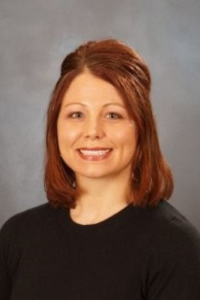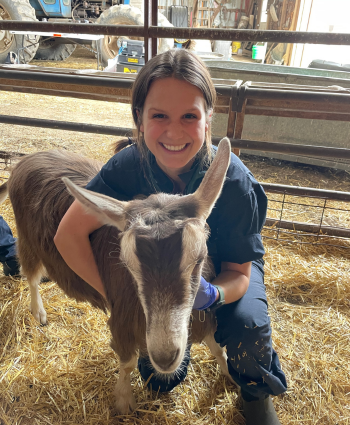Communication is key
Simulated clinical scenarios help DVM students build speaking and listening skills to drive better animal care

Simulated clinical scenarios help DVM students build speaking and listening skills to drive better animal care
Veterinary students and professionals understand that delivering first-rate care demands effective communication. Whether gathering a complex medical history from an animal’s owner, discussing a diagnosis and treatment plan with a referring veterinarian, or interacting with technicians and colleagues in the clinic, veterinary teams rely on skilled communication to do their jobs well.
Committed to equipping graduates with the speaking and listening skills required by the profession, the College of Veterianry Medicine (CVM) currently integrates communication content into a series of six professional development courses. Two communication-centered courses utilize objective structured clinical exams (OSCEs) to build communication skills.
Dr. Kara Carmody, an assistant professor and developer of one of the courses, understands first-hand the necessity of imparting veterinary students with strong communication skills.

“Successful communication during client encounters and navigating difficult discussions is a learned skill,” Carmody says. “Opportunities for students to practice these scenarios in a safe environment builds competence and confidence."
Commonly, veterinary schools use OSCEs for performance-based learning and assessment. These exams are direct observation assessments using simulations or recreations of veterinary encounters with clients and their pets.
The CVM offers one OSCE course simulating a clinical exam and another course recreating a patient intake or history-gathering scenario. The simulations provide a structured opportunity for students to practice and improve communication skills without risk to patient safety.
To create these courses, CVM partnered with the University of Minnesota’s M Simulation (MSim) Center. A University health sciences resource, the Center specializes in developing and implementing simulation-based teaching and assessment experiences for health sciences learners.
CVM and MSim Center offer these sessions in-person and online. The online experience makes the OSCE more accessible and affordable using online technology. Online delivery ensures the courses are more readily accessible and affordable to offer to students.
In the CVM OSCEs communication courses, MSim selects individuals to portray the client during the encounter. These individuals are often professionally trained actors who participate in specific training on delivering a scripted or standardized version of the pet’s medical history. Other standardized clients convey the information needed during a clinical exam. The clients receive training on delivering the pet's medical history and information required in a standardized clinical exam. The client actors also receive instructions on providing useful feedback to the veterinary students at the end of the session.
The CVM students enrolled in the course use the patient actors and their pets to practice the communication skills needed to gather a medical history in a safe environment to prepare them for in-person clinical rotations and clinical practice upon entering the workforce. Rather than focusing on developing and assessing the students’ clinical skills, the courses target students’ professional communication skills.
The communication materials and OSCEs developed to date receive positive reviews from students such as Sophia Farrow, a second-year DVM student who highly recommends the course.

The opportunity to practice communication skills in real-life scenarios with “staged” clients and patients helped her to gain confidence in forming a client-doctor relationship without fear of making a critical error or mistake.
“A specific skill I honed in on was making sure to use language that could be understood by the general public instead of ‘doctor talk’ when explaining medical terms to a client,” Farrow says.
Course participants like Farrow receive a rubric outlining the communication skills practiced and assessed during the exercise. The list of skills includes gathering and assimilating relevant information about an animal, listening attentively and communicating professionally, adapting communication style to clients and colleagues, and, importantly, demonstrating inclusivity and cultural competence.
CVM hopes to expand the opportunities to build communication skills that encompass scenarios such as challenging client interactions by offering additional OSCEs. Faculty plans to develop courses that provide students with the opportunity to practice on simulated patients at additional points within a typical client encounter.
Practicing these additional challenging scenarios and receiving feedback during a simulation builds confidence. Improved communication skills ultimately benefit patient care, client interactions, and job satisfaction.